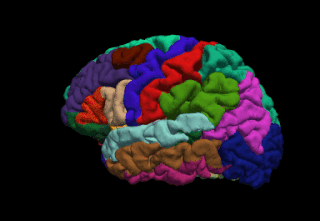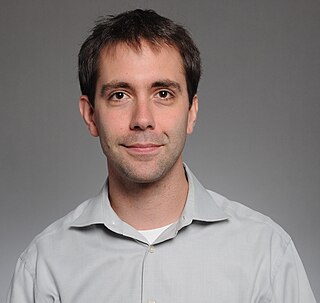The Dana Foundation is a private philanthropic organization based in New York dedicated to advancing neuroscience and society by supporting cross-disciplinary intersections such as neuroscience and ethics, law, policy, humanities, and arts.

Neuroimaging is the use of quantitative (computational) techniques to study the structure and function of the central nervous system, developed as an objective way of scientifically studying the healthy human brain in a non-invasive manner. Increasingly it is also being used for quantitative research studies of brain disease and psychiatric illness. Neuroimaging is highly multidisciplinary involving neuroscience, computer science, psychology and statistics, and is not a medical specialty. Neuroimaging is sometimes confused with neuroradiology.
Brain mapping is a set of neuroscience techniques predicated on the mapping of (biological) quantities or properties onto spatial representations of the brain resulting in maps.

FreeSurfer is brain imaging software originally developed by Bruce Fischl, Anders Dale, Martin Sereno, and Doug Greve. Development and maintenance of FreeSurfer is now the primary responsibility of the Laboratory for Computational Neuroimaging at the Athinoula A. Martinos Center for Biomedical Imaging. FreeSurfer contains a set of programs with a common focus of analyzing magnetic resonance imaging (MRI) scans of brain tissue. It is an important tool in functional brain mapping and contains tools to conduct both volume based and surface based analysis. FreeSurfer includes tools for the reconstruction of topologically correct and geometrically accurate models of both the gray/white and pial surfaces, for measuring cortical thickness, surface area and folding, and for computing inter-subject registration based on the pattern of cortical folds.
Bin He is a Chinese American biomedical engineering scientist. He is the Trustee Professor of the Department of Biomedical Engineering, professor by courtesy in the Department of Electrical and Computer Engineering, and Professor of Neuroscience Institute, and was the head of the department of Biomedical Engineering at Carnegie Mellon University. Prior, he was Distinguished McKnight University Professor of Biomedical Engineering and Medtronic-Bakken Endowed Chair for Engineering in Medicine at the University of Minnesota. He previously served as the director of the Institute for Engineering in Medicine and the Center for Neuroengineering at the University of Minnesota. He was the Editor in Chief of the IEEE Transactions on Biomedical Engineering and serves as the editor in chief of IEEE Reviews in Biomedical Engineering. He was the president of the IEEE Engineering in Medicine & Biology Society (EMBS) from 2009 to 2010 and chair of International Academy of Medical and Biological Engineering from 2018 to 2021.
The Athinoula A. Martinos Center for Biomedical Imaging, usually referred to as just the "Martinos Center," is a major hub of biomedical imaging technology development and translational research. The Center is part of the Department of Radiology at Massachusetts General Hospital and is affiliated with both Harvard University and MIT. Bruce Rosen is the Director of the Center and Monica Langone is the Administrative Director.
The Human Connectome Project (HCP) is a five-year project sponsored by sixteen components of the National Institutes of Health, split between two consortia of research institutions. The project was launched in July 2009 as the first of three Grand Challenges of the NIH's Blueprint for Neuroscience Research. On September 15, 2010, the NIH announced that it would award two grants: $30 million over five years to a consortium led by Washington University in St. Louis and the University of Minnesota, with strong contributions from University of Oxford (FMRIB) and $8.5 million over three years to a consortium led by Harvard University, Massachusetts General Hospital and the University of California Los Angeles.
Anders Martin Dale is a prominent neuroscientist and professor of radiology, neurosciences, psychiatry, and cognitive science at the University of California, San Diego (UCSD), and is one of the world's leading developers of sophisticated computational neuroimaging techniques. He is the founding Director of the Center for Multimodal Imaging Genetics (CMIG) at UCSD.
Gitte Moos Knudsen is a Danish translational neurobiologist and clinical neurologist, and Clinical Professor and Chief Physician at the Department of Clinical Medicine, Neurology, Psychiatry and Sensory Sciences, at Copenhagen University Hospital. She graduated from Lyngby Statsskole, just north of Copenhagen, before gaining entrance to medicine, where she received her MD from University of Copenhagen in 1984, and became a Board certified user of radioisotopes in 1986. She sat the FMGEMS exam (US) in 1989. She became Board certified in neurology in 1994 and received her DMSc (Dr.Med.) from University of Copenhagen in 1994. She currently resides in Copenhagen, and is married to Tore Vulpius. She has 3 children.
The following outline is provided as an overview of and topical guide to brain mapping:
Bruce Rosen is an American physicist and radiologist and a leading expert in the area of functional neuroimaging. His research for the past 30 years has focused on the development and application of physiological and functional nuclear magnetic resonance techniques, as well as new approaches to combine functional magnetic resonance imaging (fMRI) data with information from other modalities such as positron emission tomography (PET), magnetoencephalography (MEG) and noninvasive optical imaging. The techniques his group has developed to measure physiological and metabolic changes associated with brain activation and cerebrovascular insult are used by research centers and hospitals throughout the world.
Randy L. Buckner is an American neuroscientist and psychologist whose research focuses on understanding how large-scale brain circuits support mental function and how dysfunction arises in illness.

Jacob M. Hooker is an American chemist and expert in molecular imaging, specifically in the development and application of combined MRI and PET. He is the Lurie FamilyProfessor of Radiology specializing in Autism Research at Harvard Medical School. He also serves as a Phyllis and Jerome Lyle Rappaport MGH Research Scholar, director of radiochemistry at the Martinos Center for Biomedical Imaging and scientific director at the Lurie Center for Autism at Massachusetts General Hospital.
Vitaly Napadow is an American neuroscientist and acupuncturist. He is a full professor of Physical Medicine & Rehabilitation and Radiology at Harvard Medical School. He is also the Director of the Scott Schoen and Nancy Adams Discovery Center for Recovery from Chronic Pain at Spaulding Rehabilitation Hospital and Director of the Center for Integrative Pain NeuroImaging at the Martinos Center for Biomedical Imaging at Massachusetts General Hospital. He is a former president of the Society for Acupuncture Research. He has been a pain neuroimaging researcher for more than 20 years. Somatosensory, cognitive, and affective factors all influence the malleable experience of chronic pain, and Dr. Napadow’s Lab has applied human functional and structural neuroimaging to localize and suggest mechanisms by which different brain circuitries modulate pain perception. Dr. Napadow’s neuroimaging research also aims to better understand how non-pharmacological therapies, from acupuncture and transcutaneous neuromodulation to cognitive behavioral therapy and mindfulness meditation training, ameliorate aversive perceptual states such as pain. In fact, his early career was known for researching acupuncture and its effects on the brain. He has also researched the brain circuitry underlying nausea and itch. He is also known for developing a novel approach in applying measures of resting state brain connectivity as potential biomarkers for spontaneous clinical pain in chronic pain disorders such as fibromyalgia.

Irene Mary Carmel Tracey is Vice-Chancellor of the University of Oxford and former Warden of Merton College, Oxford. She is also Professor of Anaesthetic Neuroscience in the Nuffield Department of Clinical Neurosciences and formerly Pro-Vice-Chancellor at the University of Oxford. She is a co-founder of the Oxford Centre for Functional Magnetic Resonance Imaging of the Brain (FMRIB), now the Wellcome Centre for Integrative Neuroimaging. Her team’s research is focused on the neuroscience of pain, specifically pain perception and analgesia as well as how anaesthetics produce altered states of consciousness. Her team uses multidisciplinary approaches including neuroimaging.

Leanne M. Williams is a professor in psychiatry and behavioural sciences at Stanford University. She is also the founding director of the Stanford Center for Precision Mental Health and Wellness and of the Precision Psychiatry and Translational Neuroscience Laboratory in the Stanford Medical School.
Catherine J. Price is a British neuroscientist and academic. She is Professor of Cognitive Neuroscience and director of the Wellcome Trust Centre for Neuroimaging at University College London.

Lucina Q. Uddin is an American cognitive neuroscientist who is a professor at the University of California, Los Angeles. Her research investigates the relationship between brain connectivity and cognition in typical and atypical development using network neuroscience approaches.
Kathryn T. Hall is a leader in placebo research, Assistant professor of medicine part-time and molecular biologist who directs research or teaches at several institutions, including the following:
Suzanne N. Haber is an American academic and neuroscientist. She is a professor at the University of Rochester, Visiting Professor at the Department of Psychiatry of Harvard Medical School, and a scientist at McLean Hospital. She is known for her research on the neural circuitry of the basal ganglia and its implications in psychiatric disorders. She is co-principal investigator on an USD 23 Mio. grant of the NIH BRAIN initiative and principal investigator of an NIH Conte Center to study obsessive–compulsive disorder. She has been councilor of the Society for Neuroscience and is editor of a scientific text book on the frontal cortex.





